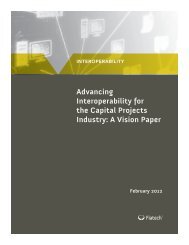An Introduction to ISO 15926 November 2011 - iRINGToday
An Introduction to ISO 15926 November 2011 - iRINGToday
An Introduction to ISO 15926 November 2011 - iRINGToday
You also want an ePaper? Increase the reach of your titles
YUMPU automatically turns print PDFs into web optimized ePapers that Google loves.
Map <strong>to</strong> Common Dictionary<br />
Map from Common Dictionary<br />
Engineering Application<br />
Line Table<br />
tag_no dia len temp press ifc wcolor<br />
tag_no dia len temp press ifc wcolor<br />
szTag dDia dLen dTemp dPress dateIFC oColor1<br />
szTag dDia dLen dTemp dPress dateIFC oColor1<br />
id dia cl temp press ifc color<br />
id dia cl temp press ifc color<br />
Line Table<br />
Construction Application<br />
New Definition<br />
New Definition<br />
Industry<br />
Reference<br />
Data<br />
Fig 1.12 Public extensible dictionary.<br />
What each developer does, independent of the other, is consult the public dictionary <strong>to</strong> see<br />
whether or not there is an attribute (or “class,” as it is properly known) that describes the<br />
color of widgets. In the previous example, there is such an attribute: ColorW. Each developer—again,<br />
independent of the other—creates their map. The engineering application maps<br />
wcolor <strong>to</strong> ColorW, and the construction application maps ColorW <strong>to</strong> color.<br />
Note that neither developer had any constraints on what they named the attribute internally,<br />
nor had <strong>to</strong> consult the other <strong>to</strong> configure their own half of the database map. Indeed, the two<br />
developers could have been on different continents—each speaking a different language.<br />
Thus, we are now back <strong>to</strong> the first benefit of <strong>ISO</strong> <strong>15926</strong>; that it has a publicly available data<br />
dictionary. 7 The simple fact that the data dictionary exists means that an organization does<br />
not have <strong>to</strong> develop one of its own. The <strong>ISO</strong> <strong>15926</strong> dictionary can be used for any purpose<br />
without royalty payment.<br />
However, what if in the previous example the public dictionary did not have a term for the<br />
color of widgets? Even if the dictionary were 100-percent up <strong>to</strong> date when it was first published,<br />
new technology would undoubtedly require new terminology. So, another requirement<br />
for the <strong>ISO</strong> <strong>15926</strong> data dictionary is that it be able <strong>to</strong> handle change.<br />
To handle change, the developers of <strong>ISO</strong> <strong>15926</strong> envision a library that will allow anyone (perhaps<br />
with the requirement of a bit of training first) <strong>to</strong> add new terms. A pilot project, called<br />
the RDS/WIP (Reference Data Service/Work in Progress), is in operation—sufficient <strong>to</strong> handle<br />
research needs. One of the current development efforts of <strong>ISO</strong> <strong>15926</strong> is <strong>to</strong> create an industrialscale<br />
reference data library.<br />
With a fully functioning, publically available RDS we will enable organic growth. Each organi-<br />
7. Truth in advertising: <strong>ISO</strong> <strong>15926</strong> does not intend <strong>to</strong> have a complete data dictionary for all of “life, the<br />
universe, and everything.” It contains an “initial” dictionary and specifies how <strong>to</strong> extend it.<br />
CHAPTER 1<br />
28



